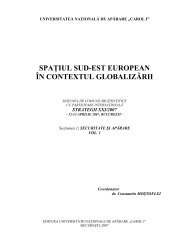PROVOCĂRI LA ADRESA SECURITĂŢII ŞI STRATEGIEI LA ÎNCEPUTUL SECOLULUI XXI
provocări la adresa securităţii şi strategiei la începutul secolului xxi
provocări la adresa securităţii şi strategiei la începutul secolului xxi
You also want an ePaper? Increase the reach of your titles
YUMPU automatically turns print PDFs into web optimized ePapers that Google loves.
This situation is markedly different from the Cold War period. In<br />
addition, the South-Eastern flank of NATO is today one the key of the<br />
region.<br />
There are two very important security issues.<br />
The first, NATO reiterate his commitment to the Conventional<br />
Armed Forces in Europe (CFE). Treaty as a cornerstone of European<br />
security, and NATO reaffirm his attachment to the early into force of the<br />
Adapted Treaty. NATO recalls that fulfillment of the remaining Istanbul<br />
commitments on the Republic of Georgia and the Republic of Moldova will<br />
create the conditions for the Allies and other States Parties to move forward<br />
on ratification of the Adapted Treaty. NATO notes the progress that was<br />
made in 2003 on withdrawal of Russian military forces from the Republic of<br />
Moldova. NATO regret that this progress has not continued in 2004 and that<br />
the extended 31 December 2003 completion date, agree in the framework of<br />
the OSCE, was not meet. It is essential that efforts be intensified to complete<br />
the withdrawal as soon as possible. NATO will continue, via OSCE, to<br />
monitor and assist in this process. NATO urges a swift resolution of the<br />
outstanding, issues between Georgia and Russia as set out in their Istanbul<br />
Joint Statement of 17 November 1999 [1].<br />
The second, The Istanbul Summit Communiqué stated that NATO<br />
will take a number of steps further strengthen the Euro-Atlantic Partnership,<br />
in particular through a special focus on engaging with our Partners in the<br />
strategically important regions of Caucasus and Central Asia [2].<br />
For these reasons, it could be not enough to operate, in the<br />
geostrategical field only the concept „The Black Sea Region”. It is<br />
necessary to operate with one wider concept for this area „The Greater<br />
Black Sea Region”.<br />
There are many reasons for this concept; but it is sufficient to show<br />
only two: „the connection of the frozen conflicts of this region” and „the<br />
energy transport corridors”.<br />
The center of gravity for the last 50 years in the alliance has been in<br />
Western Europe, but the center of activity is moving east, the geostrategic<br />
center of interest for foreseeable future has to be the greater Middle East [3].<br />
The Russian Federation, Turkey and Ukraine are the three major<br />
players in the region by all-important measures of power: size, population,<br />
real and potential economic power and military capability.<br />
There are plans of creating a security zone from the Baltic to the<br />
Black Sea. Rapidly evolving and strengthening is the Kyiv-Warsaw axis<br />
which in our opinion is in a position to form a gravitational field and involve<br />
the cooperation of third countries such as Lithuania or Romania.<br />
Transformation of the Weimar triangle (Warsaw-Bonn-Paris) into<br />
quadrangle with Kiev’s participation could become a fundamental factor of<br />
security in East Central Europe. It is important to emphasize that the sphere<br />
of Ukraine’s regional interests extends beyond Central European structures<br />
and cover those which unite countries of the Black Sea and Mediterranean<br />
regions, including Georgia, Azerbaijan and Armenia [4].<br />
Our proposal suggests operating in the security field with the<br />
concept „The Wider Black Sea Region” instead of „The Black Sea Region”.<br />
The Black Sea Region: Romania, Ukraine, Russia, Georgia,<br />
Turkey, Bulgaria<br />
The Wider Black Sea Region (WBSR): Romania, Ukraine, Russia,<br />
Georgia, Turkey, Bulgaria, Moldova, Armenia, Azerbaijan.<br />
II. Geopolitical perspective: WBSR countries and their security<br />
problems<br />
The geopolitical perspective must take in account the spatial<br />
dynamics of contemporary WBSR, particularly the development of non- and<br />
trans- national spaces, the changing nature of European borders, and<br />
emergent forms of spatial governance, particularly those associated with<br />
cities, trans-border regions, pan-European networks, and polycentric<br />
development. While there is much research being conducted on WBSR<br />
(regions, cities, Euro-land etc.), EU borders (enlargement, cross-border<br />
flows and mobilities, problems associated with peripheries), and the nature<br />
of EU governance applied to WBSR (multi-level, networked, EU-as-polity),<br />
there is much less work devoted to understanding the concept of “friendly<br />
vicinity” (relationship between spaces, borders and governance).<br />
The issue of EU borders has attracted a lot of attention in recent<br />
years, particularly in terms of the problems of maintaining territorial<br />
security and the ability to control flows in the context of threats stemming<br />
from transnational crime, trafficking, and terrorism in a Europe increasingly<br />
characterised by mobilities, networks and ‘borderless Europe.’ Borders are<br />
also important because they are increasingly seen to have a spatial<br />
dimension, best represented by the idea of ‘borderlands,’ and the fact that<br />
EU borders are not necessarily to be found at national or European<br />
perimeters but also at airports and other gateways.<br />
281<br />
282





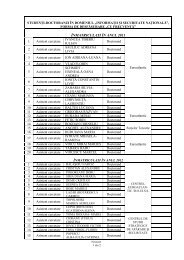
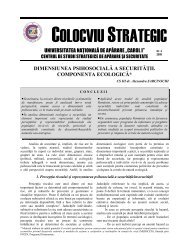
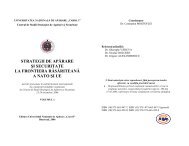
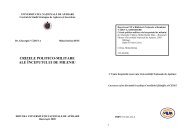
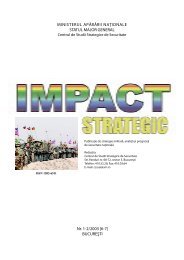




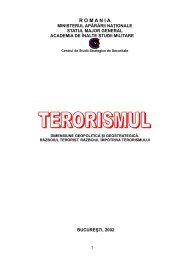

![„CAROL Nr 4 [29]/2008](https://img.yumpu.com/53801719/1/184x260/carol-nr-4-29-2008.jpg?quality=85)
